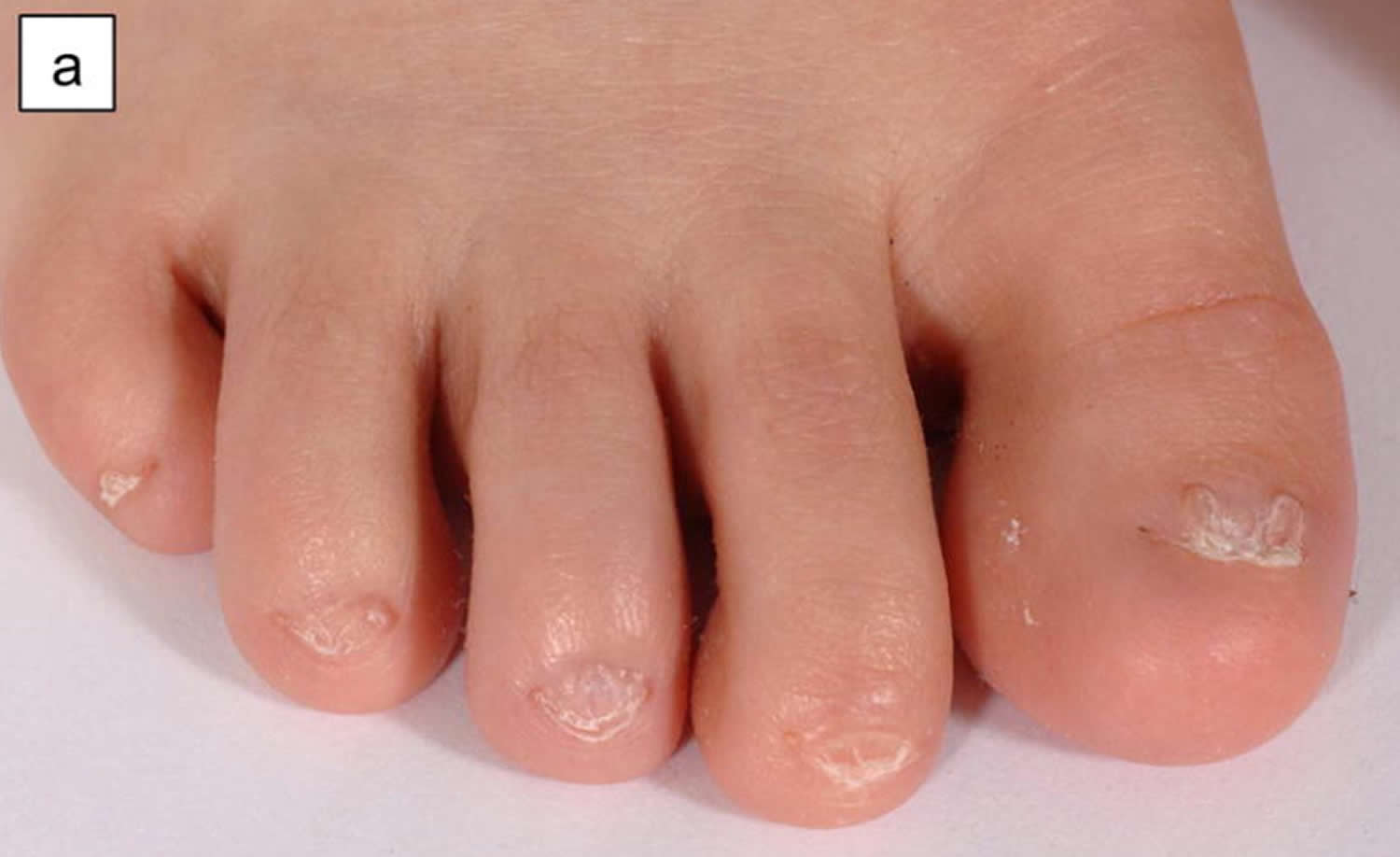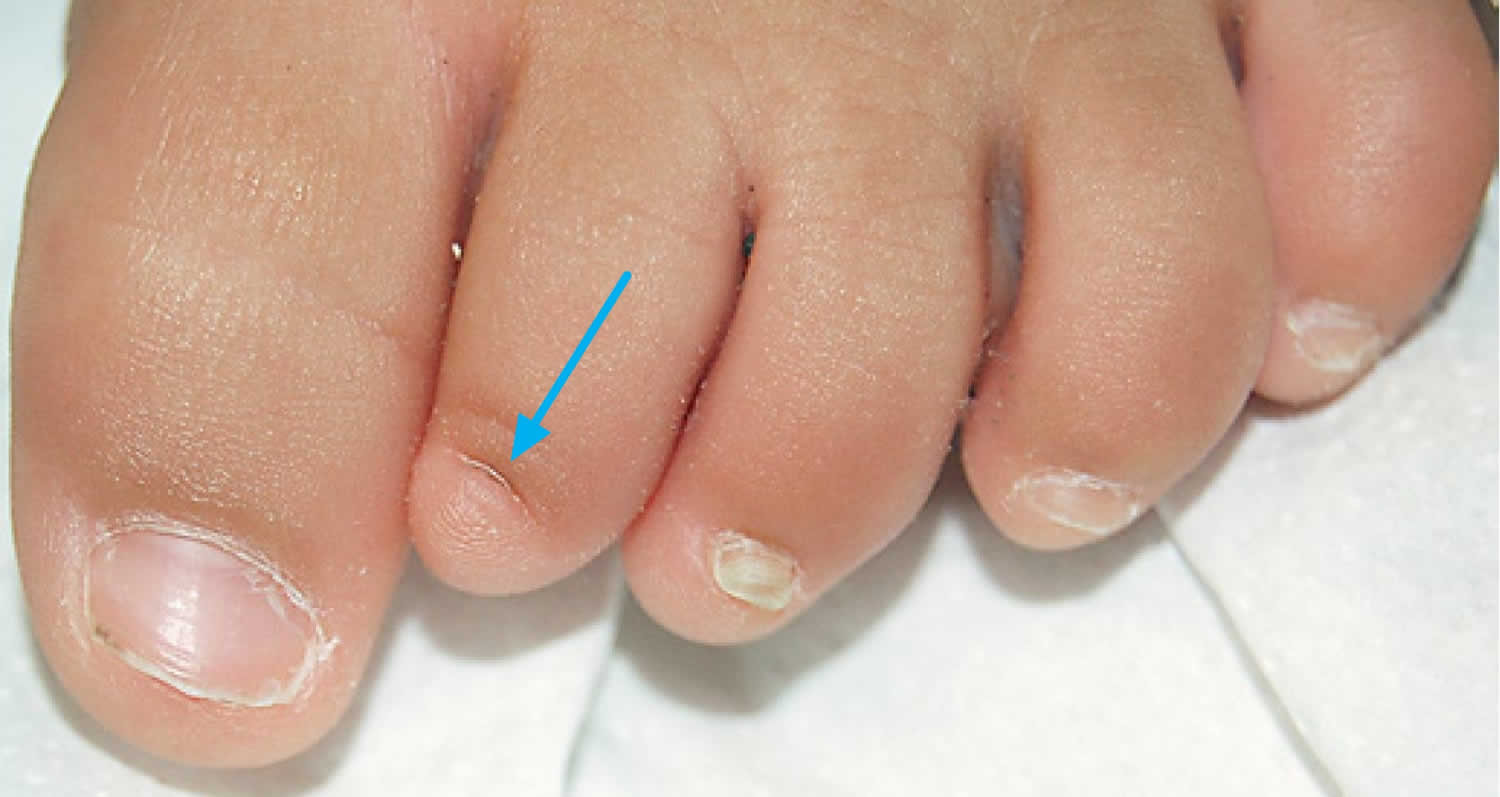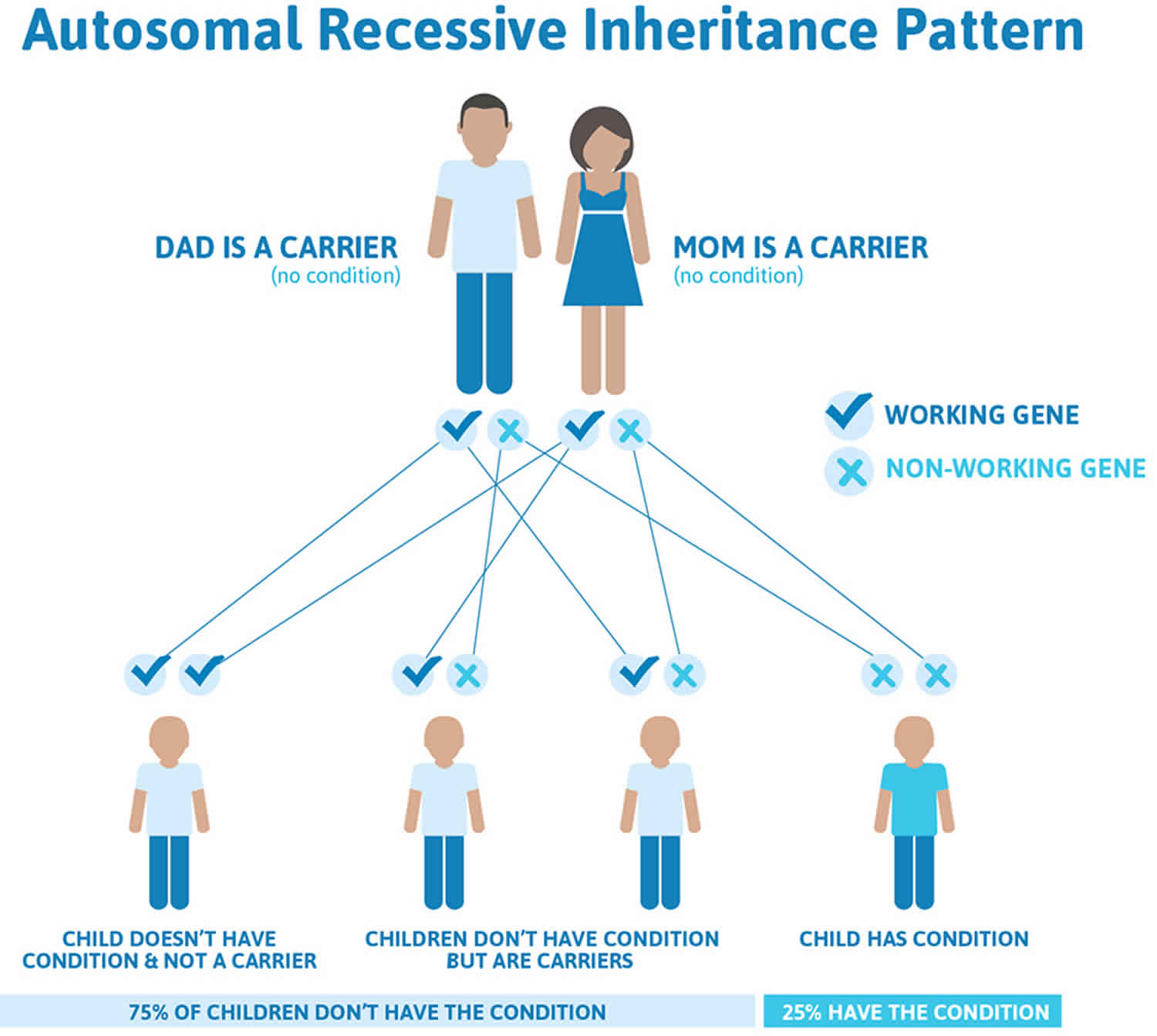Anonychia
Anonychia is the partial or complete absence of fingernails and/or toenails 1. Anonychia (absence of nails) is a very rare congenital or acquired anomaly 2. Anonychia may be the result of a congenital ectodermal dysplasias, congenital anonychia associated with other deformities describing an autosomal or recessive inheritance (Coffin-Siris syndrome, ectodermal dysplasias, nail-patella syndrome or brachydactyly type B) 3, ichthyosis, severe infection, severe allergic contact dermatitis, self-inflicted trauma, Raynaud phenomenon, lichen planus, epidermolysis bullosa 4 or severe exfoliative diseases 5.
Coffin-Siris syndrome is a multiple malformation syndrome characterized by mental retardation associated with coarse facial features, hypertrichosis, sparse scalp hair, and hypoplastic or absent fifth fingernails or toenails 6. Other more variable features may include poor overall growth, craniofacial abnormalities, spinal anomalies, and congenital heart defects 7. Mutations in the ARID1B gene are the most common cause of Coffin-Siris syndrome 8.
Isolated congenital anonychia is characterized by nail abnormalities ranging from onychodystrophy (dystrophic nails) to anonychia (absence of nails) 9. Onychodystrophy-anonychia has been described in at least four generations of a family with male-to-male transmission, suggesting autosomal dominant transmission. Anonychia has been described in approximately less than 20 cases; it is likely to be transmitted as an autosomal recessive trait. Total anonychia congenita, in which all the fingernails and toenails are absent, may have an autosomal dominant inheritance pattern.
Figure 1. Congenital anonychia
Anonychia causes
Congenital anonychia has been described in association with a wide variety of other congenital anomalies like nail-patella syndrome, DOOR syndrome (deafness, onychodystrophy, osteodystrophy and mental retardation), AEC syndrome (ankyloblepharon, ectodermal defects, cleft lip/palate), EEC syndrome (ectodactyly, ectodermal dysplasia, cleft lip/palate), TOOD syndrome (tricho-odonto-onycho-dermal), hypohidrotic ectodermal dysplasia with multiple anomalies and various craniofacial malformation syndromes 2. As an underlying bone is a prerequisite for the development of a normal nail, anonychia or hyponychia may occur when the terminal phalynx is either hypoplastic or completely absent 10. Simple anonychia, meaning the congenital absence of the nails without any other coexisting major congenital anomaly, is an extremely rare variety of this condition. This is mostly due to autosomal recessive inheritance. Isolated anonychia without any associated phenotypical disturbances is one of the rarest anomalies of congenital nail disorders. Some or all fingers of the hands or feet could be affected. Anonychia can also be encountered in dermatologic disorders like pemphigus, lichen planus, icthyosis, severe infection, severe allergic contact dermatitis, self-inflicted trauma, Raynaud phenomenon, severe exfoliative diseases, epidermolysis bullosa, and as a sequel of Stevens-Johnson syndrome 11.
Nail development begins at 8-10 weeks of expected gestational age and is completed by the fifth month of expected gestational age. The flat rectangular surface of the future nail bed on the dorsal tips is first demarcated by folds visible at 8-10 weeks of expected gestational age 11. Drugs administered to the mother during the first and second trimester of pregnancy are extremely significant factors for nail formation. Phenytoin and warfarin may cause hypoplasia of nails, while alcohol may lead to possible anonychia 12.
The mode of inheritance of most of these disorders has not yet been established with certainty. Isolated, nonsyndromic anonychia may present either as an autosomal dominant form that affects only the thumbs or in its severe, autosomal recessively inherited variant, with involvement of all digits and toes. Recently, the R-spondin-4 gene (RSPO4) gene was identified as being responsible for anonychia. It is a member of the R-spondin family of secreted proteins that play a major role in activating the Wnt/beta-catenin signaling pathway, which plays a pivotal role in embryonic development, growth regulation, and cancer development 13.
Littman and Levin 14 described a brother and sister with absent nails in seven digits and suggested the condition to be of recessive inheritance. Anonychia in association with neurological defects such as choreoathetosis and epilepsy, in a family showing a vertical transmission was described 15.
Anonychia congenita
Anonychia congenita also called congenital absence of nails, isolated congenital anonychia or autosomal recessive nonsyndromic congenital nail disorder type 4, is a very rare genetic condition that affects the fingernails and toenails. Individuals with anonychia congenita are typically missing all of their fingernails and toenails (anonychia). This absence of nails is noticeable from birth (congenital). In some cases, only part of the nail is missing (hyponychia) or not all fingers and toes are affected. All of the other tissues at the tips of the fingers and toes, including structures that usually support the nail and its growth (such as the nail bed), are normal.
Individuals with anonychia congenita do not have any other health problems related to the condition.
Anonychia congenita is a very rare condition; its prevalence is unknown 16.
Mutations in the R-spondin-4 gene (RSPO4) gene cause anonychia congenita 17.
Anonychia congenita can also be part of syndromes that affect multiple parts of the body, including Coffin-Siris syndrome and nail-patella syndrome. When anonychia congenita is part of a syndrome, it is caused by mutations in the gene associated with that syndrome.
Anonychia congenita causes
Mutations in the RSPO4 gene on chromosome 20p13 cause anonychia congenita. The RSPO4 gene provides instructions for making a protein called R-spondin-4. R-spondin-4 plays a role in the Wnt signaling pathway, a series of steps that affect the way cells and tissues develop. Wnt signaling is important for cell division, attachment of cells to one another (adhesion), cell movement (migration), and many other cellular activities. During early development, Wnt signaling plays a critical role in the growth and development of nails. R-spondin-4 is active in the skeleton and contributes to limb formation, particularly at the ends of the fingers and toes where nail development occurs.
RSPO4 gene mutations lead to the production of a protein with little or no function. As a result, R-spondin-4 cannot participate in the Wnt signaling pathway and nails develop improperly or not at all.
Anonychia congenita can also be part of syndromes that affect multiple parts of the body, including Coffin-Siris syndrome and nail-patella syndrome. When anonychia congenita is part of a syndrome, it is caused by mutations in the gene associated with that syndrome.
Nail plate originates from germinative epithelium of nail matrix and grows continuously, from 15 weeks of embryonic life until death. Maternal consumption of drugs during early pregnancy can significantly alter nail development, and defects have been reported with use of alcohol, carbamazepine, phenytoin, warfarin, morphine and trimethadione 18.
Anonychia congenita inheritance pattern
Anonychia congenita resulting from RSPO4 gene mutations is inherited in an autosomal recessive pattern, which means both copies of the gene in each cell have mutations. The parents of an individual with an autosomal recessive condition each carry one copy of the mutated gene, but they typically do not show signs and symptoms of the condition.
It is rare to see any history of autosomal recessive conditions within a family because if someone is a carrier for one of these conditions, they would have to have a child with someone who is also a carrier for the same condition. Autosomal recessive conditions are individually pretty rare, so the chance that you and your partner are carriers for the same recessive genetic condition are likely low. Even if both partners are a carrier for the same condition, there is only a 25% chance that they will both pass down the non-working copy of the gene to the baby, thus causing a genetic condition. This chance is the same with each pregnancy, no matter how many children they have with or without the condition.
- If both partners are carriers of the same abnormal gene, they may pass on either their normal gene or their abnormal gene to their child. This occurs randomly.
- Each child of parents who both carry the same abnormal gene therefore has a 25% (1 in 4) chance of inheriting a abnormal gene from both parents and being affected by the condition.
- This also means that there is a 75% ( 3 in 4) chance that a child will not be affected by the condition. This chance remains the same in every pregnancy and is the same for boys or girls.
- There is also a 50% (2 in 4) chance that the child will inherit just one copy of the abnormal gene from a parent. If this happens, then they will be healthy carriers like their parents.
- Lastly, there is a 25% (1 in 4) chance that the child will inherit both normal copies of the gene. In this case the child will not have the condition, and will not be a carrier.
These possible outcomes occur randomly. The chance remains the same in every pregnancy and is the same for boys and girls.
Figure 2 illustrates autosomal recessive inheritance. The example below shows what happens when both dad and mum is a carrier of the abnormal gene, there is only a 25% chance that they will both pass down the abnormal gene to the baby, thus causing a genetic condition.
Figure 2. Anonychia congenita autosomal recessive inheritance pattern
People with specific questions about genetic risks or genetic testing for themselves or family members should speak with a genetics professional.
Resources for locating a genetics professional in your community are available online:
- The National Society of Genetic Counselors (https://www.findageneticcounselor.com/) offers a searchable directory of genetic counselors in the United States and Canada. You can search by location, name, area of practice/specialization, and/or ZIP Code.
- The American Board of Genetic Counseling (https://www.abgc.net/about-genetic-counseling/find-a-certified-counselor/) provides a searchable directory of certified genetic counselors worldwide. You can search by practice area, name, organization, or location.
- The Canadian Association of Genetic Counselors (https://www.cagc-accg.ca/index.php?page=225) has a searchable directory of genetic counselors in Canada. You can search by name, distance from an address, province, or services.
- The American College of Medical Genetics and Genomics (http://www.acmg.net/ACMG/Genetic_Services_Directory_Search.aspx) has a searchable database of medical genetics clinic services in the United States.
Anonychia congenita symptoms
Anonychia congenita is a very rare genetic condition that affects the fingernails and toenails. Individuals with this condition are typically missing all of their fingernails and toenails (anonychia). This absence of nails is noticeable from birth (congenital). In some cases, only part of the nail is missing (hyponychia) or not all fingers and toes are affected. All of the other tissues at the tips of the fingers and toes, including structures that usually support the nail and its growth (such as the nail bed), are normal.
Individuals with anonychia congenita do not have any other health problems related to the condition.
Anonychia congenita diagnosis
Anonychia congenita diagnosis is based on medical and family history and careful physical examination. X-rays of the right upper limb and foot of individual showed normal results. No additional malformations were found on clinical examination of affected siblings, neither of ectodermal structures nor of sensory organs. Your skin doctor may order a molecular genetic test for the RSPO4 gene.
Anonychia congenita treatment
Anonychia congenita treatment involves prosthetic acrylic nails for cosmesis or reassurance with no treatment.
References- Der Kaloustin VM, Kurban AK (1979) Genetic diseases of the skin. Springer Verlag, Berlin, pp 196–198
- Yadalla HK, Nitya R, Sujatha C. A rare case of isolated congenital complete simple anonychia. Int J Health Allied Sci [serial online] 2012 [cited 2020 Oct 12];1:32-3. https://www.ijhas.in/text.asp?2012/1/1/32/96419
- Bergmann C, Senderek J, Anhuf D, et al. Mutations in the gene encoding the Wnt-signaling component R-spondin 4 (RSPO4) cause autosomal recessive anonychia. Am J Hum Genet. 2006;79(6):1105-1109. doi:10.1086/509789 https://www.ncbi.nlm.nih.gov/pmc/articles/PMC1698700
- Tosti A, de Farias DC, Murrell DF. Nail involvement in epidermolysis bullosa. Dermatol Clin. 2010;28:153–157.
- James, William; Berger, Timothy; Elston, Dirk (2005). Andrews’ Diseases of the Skin: Clinical Dermatology. (10th ed.). Saunders. ISBN 0-7216-2921-0.
- COFFIN-SIRIS SYNDROME 1; CSS1. https://omim.org/entry/135900
- Vergano SS, Deardorff MA. Clinical features, diagnostic criteria, and management of Coffin-Siris syndrome. Am J Med Genet C Semin Med Genet. 2014 Sep;166C(3):252-6. doi: 10.1002/ajmg.c.31411. Epub 2014 Aug 28.
- A comprehensive molecular study on Coffin-Siris and Nicolaides-Baraitser syndromes identifies a broad molecular and clinical spectrum converging on altered chromatin remodeling. Human Molecular Genetics, Volume 22, Issue 25, 20 December 2013, Pages 5121–5135, https://doi.org/10.1093/hmg/ddt366
- Isolated congenital anonychia. https://www.orpha.net/consor/cgi-bin/OC_Exp.php?lng=en&Expert=79143
- Cynthia AL, Tamakoss D. Embryology. In: Bolognia JL, Jorizzo JL, Rapini RP, editors. Dermatology. 2 nd ed. India: Mosby Elsevier; 2008. p. 37-47.
- Samman PD. The nails. In: Rook A, Wilkinson DS, Ebling FJG, editors. Text Book of dermatology. 3 rd ed. New Delhi: CBS Publishers; 1986. p. 1823-55.
- Lawry M, Daniel CR. Nails in systemic disease. In: Scher RK, Daniel CR, editors. Nails: Diagnosis, Therapy, Surgery. 3 rd ed. Philidelphia: Elsevier Science Limited; 2005. p. 147-69.
- Ishii Y, Wajid M, Bazzi H, Fantauzzo KA, Barber AG, Blaydon DC, et al. Mutations in R-spondin 4 (RSPO4) underlie inherited anonychia. J Invest Dermatol 2008;128:867-70.
- Littman A, Levin S. Anonychia as a recessive autosomal trait in man. J Investigative Dermatol 1964;42:177-8.
- Mété D, Hurbin E, Wind P. Congenital anonychia. Rev Prat 2006;56:1874.
- Anonychia congenita. https://medlineplus.gov/genetics/condition/anonychia-congenita
- Blaydon DC, Ishii Y, O’Toole EA, Unsworth HC, Teh MT, Rüschendorf F, et al. The gene encoding r-spondin 4 (RSPO4), a secreted protein implicated in wnt signaling, is mutated in inherited anonychia. Nat Genet. 2006;38:1245-7
- Padmavathy L, Kanthimathi B, Rao L, Adaikappan M(2016) Congenitalanonychia affecting both little fingers – a “formefruste” of cooks syndrome? A case report. Glob Dermatol, 2: DOI: 10.15761/GOD.1000169







